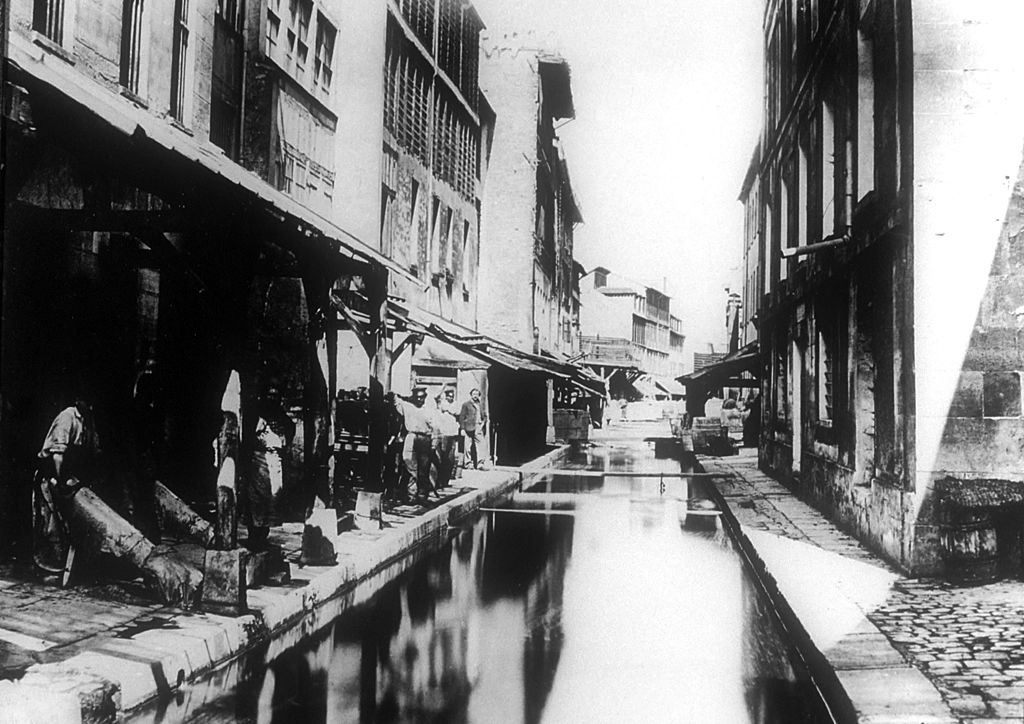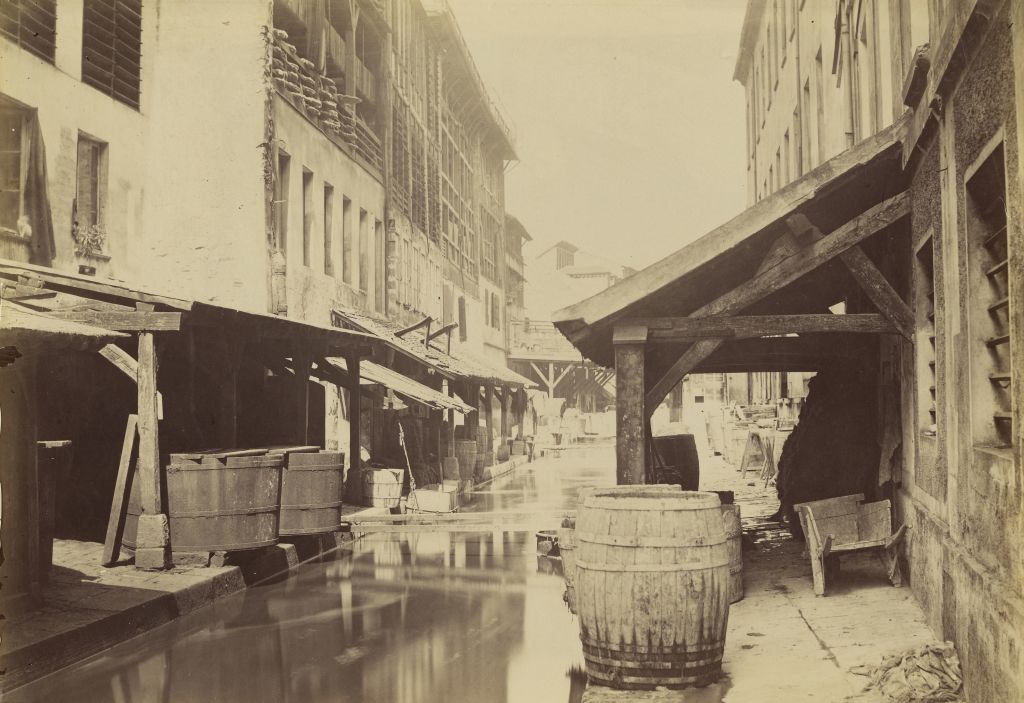
In 1899, a writer for French newspaper Le Figaro surveyed the damage Parisians had done to the Bièvre, a river that for hundreds of years had snaked up through southern Paris, joining the Seine near the Jardin des Plantes. “It flows slowly, oily and black, streaked with acids, dotted with soapy and putrid pustules,” the writer observed. “In the sparse and sordid grass, peeled like the back of a worn-out horse, parasitic plants grow in abundance.”
The waterway, averaging 13 ft. in width, had featured in Renaissance poetry by François Rabelais and in Victor Hugo’s Les Misérables. But as the Industrial Revolution took off, masses of tanneries, dyers and laundries used and abused the Bièvre’s waters, leaving it resembling an open-air sewer, which authorities decided to pave over. “Tomorrow,” Le Figaro mourned as the 20th century approached, “this once ‘beautiful river’ … will be walled up and bewitched like a sorceress during the middle ages, and in this strange and desolate valley … a new district of tall and flaming buildings will rise.”
Paris’ last stretch of the Bièvre was sealed up in 1912. Since then, a deep-rooted cultural fascination with the lost river has powered several heritage campaigns to reopen it. But none have succeeded: its waters no longer even run under the city, having been cut off at towns closer to its source, 13 miles southwest of Paris.
Today, though, the Bièvre has an unlikely ally: climate change. The same industrial activity that destroyed the river has helped drive global warming, with Paris’ average temperature already 4.1°F (2.3°C) higher than in Rabelais’ day. The urban heat-island effect, in which buildings and paved roads absorb more heat than vegetation and water do, is making matters worse, driving Paris’ temperature up by as much as 14.4°F (8°C) than nearby rural areas during heatwaves. By the mid-21st century, according to local government estimates, Paris could have a climate resembling the much hotter city of Seville in southern Spain.
“We have to adapt Paris to the future and yet, this is one of the most densely populated cities in the world, and on top of that, it’s a historic city with lots of heritage restrictions, so we are limited in what we can do,” says Dan Lert, Paris’ deputy mayor for climate, water and energy. “La Bièvre is one of the great tools that we have.”

Living with nature
Bodies of water, just like trees and plants, help to cool down their surrounding areas: water absorbs heat from the air, and when water particles evaporate, they carry the heat away with them, lowering the ground-level temperature. They can also mitigate floods by giving excess rainwater somewhere to go, and make cities a more pleasant place to live. So it makes sense that Parisians would welcome the return of a long-lost waterway. Paris’ Green Party proposed “the rebirth of la Bièvre” during the campaign for elections last year, and Mayor Anne Hidalgo’s Socialist Party agreed to pursue it as part of a coalition deal. A feasibility study is underway and Lert expects to complete the first section within city limits by the end of the mayor’s current term in 2026. It will join several stretches of the Bièvre uncovered over the last few years in smaller towns, in parks and other underdeveloped areas.
The Bièvre is far from the first urban river to get a new chance at life in the climate change era. A movement to “daylight” rivers has been building for roughly a decade. In 2014, Auckland, New Zealand, stripped away thousands of cubic meters of clay and pipes to uncover streams in its city center. In May of this year, a construction team in Manchester, U.K. uncovered a downtown section of the River Medlock, which was buried in an underground tunnel 50 years ago. Authorities in New York City are currently studying a $130 million plan to reopen the Tibbetts Brook in the Bronx, which was enclosed in a drain around the same time as the Bièvre, to help mitigate growing flood risks.
Read More: City Heat is Worse if You’re Not Rich or White. The World’s First Heat Officer Wants to Change That
The trend represents a reversal among urban leaders, who for centuries saw limiting nature’s footprint as crucial to development, says Snigdha Garg, head of adaptation research at C40, a coalition of 97 cities seeking to be climate leaders. In July, Paris, along with 30 other major cities, signed a C40 pledge to expand blue and green spaces by 2030, either to cover 30-40% of city surface area or to make sure 70% of city residents are living within 15 minutes of them.
“We are seeing that it’s moving away from nature—whether that’s the true course of a river or where trees should be—that is causing many of our problems,” Garg says. “And now, gradually, cities are learning to live with nature.”
Keeping the AC off
On July 25, 2019, Paris recorded its highest temperature in history, at 108.7°F (42.6°C). A government study published in September predicts that unusually intense and long heat waves, which the city endured in 2018, 2019 and 2020, will likely become common in summertime within a few decades, potentially stretching into spring and autumn.
Paris must adapt to its new climate, but city officials are keen to avoid one measure in particular. “We want at all costs to prevent Parisians resorting to individual air conditioning systems; unlike U.S. cities, it’s not yet an established custom here,” Lert says. Though hotels, shops and restaurants sometimes offer AC, it remains exceedingly rare in Paris’ private homes, which were mostly built in a pre-AC era.
Read More: Extreme Heat in the American West Shows Climate Change is Here
While they may cool the inside of a building effectively, AC units also belch heat out into city streets. A city-commissioned study found that if use of individual units became widespread across Paris, it would increase the outside temperature by 3.6-5.4°F (2-3°C) during heatwaves. That’s not even to speak of the surge in greenhouse-gas emissions that would come from an increase in AC usage, which would threaten the city’s 2050 net zero target.
Instead, to keep Paris cool, officials want to rely largely on greenery (with 170,000 trees to be planted by 2027) and the city’s rivers. Paris has a district cooling system—an environmentally friendly technology that uses water or another medium to move heat from hotter areas to naturally cooler ones—that’s the largest in Europe. Built in 1991, it pumps chilled water from the Seine across 56 miles (90 km) of pipes to cool hotels, department stores, offices, museums and more. Over the next 20 years, the city plans to triple the length of the network and hook up all of its hospitals and healthcare centers.
A push to clean up rivers will also give Parisians more opportunities to take a dip. By the 2024 summer Olympics, the city wants to realize the long-held dream of making the Seine swimmable. Years of incremental improvements to water quality, thanks to better waste management, have already allowed the city to open, in 2017, a free-to-use swimming area in the eastern Canal Saint Martin: the pool’s waters are separated from the rest of the canal only by a mesh filter to keep out leaves. It receives around 100,000 visitors every summer. To allow swimming in the Seine—a much bigger and harder to control waterway—the city is taking a bolder step: constructing a 46,000-cubic-meter underground water tank currently in the works near the Gare D’Austerlitz, a central train station. During storms, the tank will store excess water, preventing sewers from overflowing and spilling harmful bacteria into the Seine.
A symbol of progress
The Bièvre also owes its likely rebirth to improvements in water quality. Throughout the 1900s, the foul contents of the river prompted smaller towns along its course to pave over it or divert it into pipes. But over the last two decades, the regional Seine-Normandie Water Agency has worked to fix poorly made pipes that leaked wastewater into the Bièvre, and tightened monitoring of the homes and businesses located along its course. The water quality is now good enough that several towns have been able to uncover stretches of the river, each citing heat and flood risks from climate change as the reasons to do so: at L’Haÿ-les-Roses, 3.5 miles from southern Paris, in 2016; at Massy, 8 miles away, in 2018; and at Jouy-en-Josas, 11 miles away, in May of this year.
In the spring of 2022, Arcueil, a densely populated suburb just outside Paris’ city limits, will reopen a 0.37 mile (600m) stretch of the Bièvre, at which point its waters will also begin flowing through underground channels in Paris, meeting the Seine again (and technically contributing a little water to the district cooling system). The water will be diverted to a treatment plant during rainy weather. “The fact we can do this shows we’re going in the right direction on water quality,” Lert says.
The first Parisian section of the Bièvre to reopen will be in Parc Kellerman, a public park on the southwestern edge of the city. It would take two or three six-year mayoral terms, Lert says, to uncover all the possible sections of the river—those that won’t require demolishing buildings or other infrastructure—up to where it meets the Seine. The initial projected cost is around 14 million euros ($15.8 million at current exchange rates): half to be paid by city hall and the other half to be split between the greater Paris metropolitan authority and the regional water agency.
Read More: How Can Cities Keep Subways Safe in an Era of Climate Crisis Flooding?
Daylighting a river is almost always an expensive process, according to C40’s Garg. But, as with many costly climate adaptation projects, “the cost of damages, from heat and flooding, will be even higher if you don’t do it,” she says. For example, in 2005, Seoul built a $900 million artificial version of the Cheonggyecheon stream on the course of the original river, which had been covered up by a highway during the 1970s. The new waterway, which diverts water from an underground river, acts as a major flood-relief channel, capable of protecting the surrounding area from a 200-year storm. The Cheonggyecheon has also become a major tourist attraction, receiving 60,000 visitors a day, and is credited with revitalizing an economically moribund neighborhood. “Financially, there’s a clear case for these projects,” Garg says.
For Parisians, the rebirth of the Bièvre also represents a chance to assuage a distinctly French cultural guilt over its destruction. “The Bièvre disappeared because of the disregard of residents,” three local historians bemoaned in a book about the river published in 2002, during the last push to reopen it. “Just maybe, the new interest in the river will open a new era, in which humans will learn to live while respecting their environment.”
Correction, Jan. 24: The original version of this story misstated which political party proposed uncovering the Bièvre during the 2021 Paris election campaign. It was the Green Party, not the Socialist Party.
More Must-Reads From TIME
- The 100 Most Influential People of 2024
- Coco Gauff Is Playing for Herself Now
- Scenes From Pro-Palestinian Encampments Across U.S. Universities
- 6 Compliments That Land Every Time
- If You're Dating Right Now , You're Brave: Column
- The AI That Could Heal a Divided Internet
- Fallout Is a Brilliant Model for the Future of Video Game Adaptations
- Want Weekly Recs on What to Watch, Read, and More? Sign Up for Worth Your Time
Write to Ciara Nugent at ciara.nugent@time.com